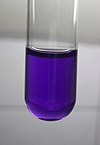Titanium(III) chloride
 |
|||
|
|||
| Names | |||
|---|---|---|---|
| Other names
titanium trichloride
titanous chloride |
|||
| Identifiers | |||
|
3D model (Jmol)
|
|||
| ChemSpider | |||
| ECHA InfoCard | 100.028.845 | ||
| EC Number | 231-728-9 | ||
|
PubChem CID
|
|||
| RTECS number | XR1924000 | ||
| UNII | |||
|
|||
|
|||
| Properties | |||
| TiCl3 | |||
| Molar mass | 154.225 g/mol | ||
| Appearance | red-violet crystals hygroscopic |
||
| Density | 2.64 g/cm3 | ||
| Melting point | 425 °C (797 °F; 698 K) (decomposes) | ||
| Boiling point | 960 °C (1,760 °F; 1,230 K) | ||
| very soluble | |||
| Solubility | soluble in acetone, acetonitrile, certain amines; insoluble in ether and hydrocarbons |
||
| +1110.0·10−6 cm3/mol | |||
|
Refractive index (nD)
|
1.4856 | ||
| Hazards | |||
| Main hazards | Corrosive | ||
| Safety data sheet | External MSDS | ||
| Related compounds | |||
|
Other anions
|
Titanium(III) fluoride Titanium(III) bromide Titanium(III) iodide |
||
|
Other cations
|
Scandium(III) chloride Chromium(III) chloride Vanadium(III) chloride |
||
|
Related compounds
|
Titanium(IV) chloride Titanium(II) chloride |
||
|
Except where otherwise noted, data are given for materials in their standard state (at 25 °C [77 °F], 100 kPa).
|
|||
|
|
|||
| Infobox references | |||
Titanium(III) chloride is the inorganic compound with the formula TiCl3. At least four distinct species have this formula; additionally hydrated derivatives are known. TiCl3 is one of the most common halides of titanium and is an important catalyst for the manufacture of polyolefins.
In TiCl3, each Ti atom has one d electron, rendering its derivatives paramagnetic, i.e. the substance is attracted into a magnetic field. The trihalides of hafnium and zirconium: in these heavier metals engage in metal-metal bonding. Solutions of titanium(III) chloride are violet, which arises from excitations of its d-electron. The colour is not very intense since the transition is forbidden by the Laporte selection rule.
Four solid forms or polymorphs of TiCl3 are known. All feature titanium in an octahedral coordination sphere. These forms can be distinguished by crystallography as well as by their magnetic properties, which probes exchange interactions. β-TiCl3 crystallizes as brown needles. Its structure consists of chains of TiCl6 octahedra that share opposite faces such that the closest Ti—Ti contact is 2.91 Å. This short distance indicates strong metal-metal interactions (See Figure in upper right). The three violet "layered" forms, named for their color and their tendency to flake, are called alpha, gamma, and delta. In α-TiCl3, the chloride anions are hexagonal close-packed. In γ-TiCl3, the chlorides anions are cubic close-packed. Finally, disorder in shift successions, causes an intermediate between alpha and gamma structures, called the delta (δ) form. The TiCl6 share edges in each form, with 3.60 Å being the shortest distance between the titanium cations. This large distance between titanium cations precludes direct metal-metal bonding. In contrast, direct Zr-Zr bonding is indicated in zirconium(III) chloride. The difference between the Zr(III) and Ti(III) materials is attributed in part to the relative radii of these metal centers.
...
Wikipedia


